Canada’s Yukon: An underexplored world-class gold district

Around the turn of the 20th century, American prospector George Carmack discovered gold on Bonanza Creek, a river in the heart of Yukon’s Klondike Region. This discovery kick-started the historic Klondike Gold Rush, which saw tens of thousands of prospectors migrating to the area in their hopes of amassing their own fortune. Many had success, although the majority left disappointed. However, there is no doubting the economic and cultural impact of this momentous event. Since 1896, 20 million ounces of placer gold has been recovered from the Klondike area, now called the White Gold District and the allure of riches continues to be a modern day attraction, with the Yukon seeing a resurgence in activity.
Since the turn of the century, the Yukon and Canadian governments have also actively supported the development of the mining industry in the district. Given the large impact that the mining industry has on the Yukon economy, it is only logical for the government to invest in the industry to further drive growth in the territory. A perfect example includes the initiatives led by the Diefenbaker government, which helped enact various road, power and airport infrastructure projects. In addition, the famous US Army-Built Alaska Highway running through the centre of the district offers essential road infrastructure to the area. Along with continued federal and territorial government support today, Yukon has become one of the most pro-mining jurisdictions in the world.
While the placer miners continue to be active, it has been hardrock explorers that have recently showed up and garnered the most attention through their activities and success in searching of the sources of the placer gold endowments. This has created a new gold rush. Starting just this past decade, there have been several notable hardrock gold discoveries across the Yukon. These include the 4 million ounce Coffee gold deposit that Goldcorp bought from Kaminak for $520 million in 2016 and the 1.5 million ounce Golden Saddle and Arc deposits that Kinross bought from Underworld Resources for $139 million in 2011. And just this year, the territory also commissioned a new multi-million ounce gold mine – Victoria Gold’s Eagle Mine 85 km north of Mayo, with numerous others at various stages of exploration and development.
For example, White Gold Corp., the largest claim holder in the White Gold District with 420,000 hectares, is diamond drilling on the Ryan’s Surprise target located approximately 2 km west of its flagship Golden Saddle/Arc deposit and 11 km south of its VG deposit.
However, even with all of placer mining and recent hardrock gold discoveries in the territory since the Klondike Gold Rush, the Yukon still remains one of the few under-explored and highly prospective gold districts in a world-class mining friendly jurisdiction. These features are undoubtedly, why the allure still lives strong today and why there is a new gold rush underway in Yukon’s White Gold District.
 White Gold Corp. [WGO-TSXV, WHGOF-OTC, 29W-FRA] is the largest claim holder in the Yukon’s prolific White Gold District owning a portfolio of 21,207 quartz claims which makes up over 420,000 hectares and over 40% of the district.
White Gold Corp. [WGO-TSXV, WHGOF-OTC, 29W-FRA] is the largest claim holder in the Yukon’s prolific White Gold District owning a portfolio of 21,207 quartz claims which makes up over 420,000 hectares and over 40% of the district.
Over a century ago, the Klondike Gold Rush spurred tens of thousands of prospectors to flock to this district in search of gold, which has now produced over 20 million ounces of placer gold. Today, a modern Yukon gold rush is underway in the district again, with over 7 million ounces of hard rock gold discoveries since 2007 driving numerous junior and major mining companies alike to try and claim a piece of this prolific district. As the largest claimholder in the district, White Gold Corp. is at the forefront of the modern Yukon gold rush, with ~1.77M oz of gold deposits, numerous high-grade gold discoveries and a large and highly prospective land package located throughout the district.
Furthermore, White Gold is led by the same team that made the recent discoveries in the district in the 21st century. White Gold’s experienced management team includes notable prospector Shawn Ryan, Chief Technical Advisor and Director, who has over 20 years of experience prospecting gold in the Yukon. A global leader in his field, his prospecting and specialization on advanced soil work led to the discovery of millions of gold ounces including the Golden Saddle and Arc deposits and Kaminak’s Coffee deposit which was sold for $520 million in 2016 to Gold Corp. Ryan has been involved with every major discovery in the White Gold District and his proprietary “drones to drill” exploration methodology continues to produce numerous new discoveries for White Gold since its inception in 2016. The company is also headed by David D’Onofrio, Chief Executive Officer, who has extensive experience in corporate finance and capital markets and a track record of success with multiple high profile mineral exploration companies. Today, the company has 131.9 million shares outstanding and is fully funded to carry out its 2020 exploration program.
The Yukon Government has also pledged hundreds of millions of dollars (Yukon Resource Gateway Project) to upgrade roads in the area to haul-grade roads, which will run through the majority of the company’s properties. This improved infrastructure creates the foundation for establishment of future mines, further accelerating the attractiveness and growth potential of the district.
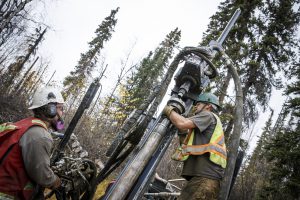 White Gold’s unique district scale opportunity in an underexplored jurisdiction, experienced and successful team, significant gold resources and prospective new discoveries has also attracted Agnico Eagle Mines Ltd. [AEM-TSX, NYSE], Kinross Gold Corp. [K-TSX; KGC-NYSE], and Eric Sprott to partner with White Gold as major investors.
White Gold’s unique district scale opportunity in an underexplored jurisdiction, experienced and successful team, significant gold resources and prospective new discoveries has also attracted Agnico Eagle Mines Ltd. [AEM-TSX, NYSE], Kinross Gold Corp. [K-TSX; KGC-NYSE], and Eric Sprott to partner with White Gold as major investors.
The company’s existing gold resources include the flagship Golden Saddle/Arc deposit hosting 1,139,900 ounces of Indicated gold and 402,100 ounces of Inferred gold, and the recently acquired neighbouring VG deposit hosting 230,000 Inferred ounces, which all remain open for expansion. In addition to defined gold resources, White Gold also has 27 early-stage properties and six discovery stage properties, including the JPR property with multiple prospects and the nearby QV property which is under-explored with excellent opportunities for new discoveries. Recent high-grade gold discoveries include the Titan (72.8 g/t gold over 6.09m), Ryan’s Surprise (20.64 g/t gold over 6.09 metres), Vertigo (11.64 g/t gold over 5.34 metres) and Betty (1.08 g/t gold over 50.29 metres), which is along strike with the Coffee deposit, now owned by Newmont.
On August 6, 2020, White Gold began its diamond drilling program on the Ryan’s Surprise target located approximately 2 km west of the Golden Saddle/Arc deposit and 11 km south of the VG deposit. The close proximity of Ryan’s Surprise to the company’s existing gold resources at Golden Saddle/Arc makes it a strategic target for the potential to add additional ounces. The current drilling forms part of the company’s fully financed 2020 exploration program backed by partners Agnico Eagle Mines and Kinross Gold. Other components of the 2020 exploration program include 1,500 metres of diamond drilling on the Titan discovery to test high-grade mineralization encountered in the 2019 RAB drilling. RAB drill holes will also test high-priority targets on the Hen and JP Ross properties. The 2020 exploration program will also include an extensive trenching and regional exploration program that will be carried out on other properties in preparation for future drill targets as the company continues to expand its exploration pipeline.
 Victoria Gold Corp. [VGCX-TSX; VITFF-OTC] made its first gold pour at its 100%-owned Eagle Gold Mine in September 2019. Located in the Dublin Gulch area of central Yukon 85 km north of Mayo and 375 km north of Whitehorse, the Eagle Mine, now in commercial production, will produce 210,000 ounces of gold annually at an all-in sustaining cost of less than US$800/oz for an estimated mine life of 11 years. Cash costs are US$577/oz.
Victoria Gold Corp. [VGCX-TSX; VITFF-OTC] made its first gold pour at its 100%-owned Eagle Gold Mine in September 2019. Located in the Dublin Gulch area of central Yukon 85 km north of Mayo and 375 km north of Whitehorse, the Eagle Mine, now in commercial production, will produce 210,000 ounces of gold annually at an all-in sustaining cost of less than US$800/oz for an estimated mine life of 11 years. Cash costs are US$577/oz.
With the recent higher gold price, it is expected that that mine life can be significantly extended as lower grade gold zones become economically viable.
The road-accessible Eagle Mine is a low-cost heap leach operation with gold recoveries of approximately 76% and open pit mining carried out at a strip ratio of 1:1 (waste:ore). Although common in the U.S. Southwest, heap leaching, which naturally generates heat, has also been successfully used in the North. There is potential to increase production with year-round stacking of crushed ore.
Measured and Indicated Mineral Resources stand at 4.4 million ounces of gold with Proven and Probable Resources at 3.3 million ounces grading 0.65 g/t gold. The Eagle Mine has a post-tax NPV5% at US$1,300/oz of +1.0 Billion.
Mining in June 2020 saw grades of 0.97 g/t gold with year-to-date grades averaging 0.86 g/t gold.
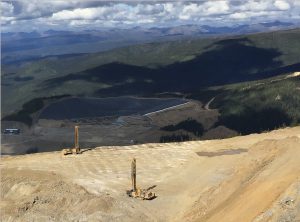 Gold resources have not been fully delineated on the Eagle Mine/Dublin Gulch property – there are numerous attractive targets needing further investigation. To this end the 2020 exploration program is testing the Raven, Nugget and Lynx targets.
Gold resources have not been fully delineated on the Eagle Mine/Dublin Gulch property – there are numerous attractive targets needing further investigation. To this end the 2020 exploration program is testing the Raven, Nugget and Lynx targets.
At the Raven and nearby Nugget area, trenching has returned 3.50 g/t gold over 124 metres and 4.68 g/t gold over 58 metres. Diamond drilling has returned 7.72 g/t gold over 2.8 metres and 5.54 g/t gold over 2.1 metres.
At the Raven target, the $3.0 million exploration program includes 7,500 metres of drilling, trenching, mapping and soil sampling. Recent drilling at Raven, where the strike length has now doubled, is focusing on step-out diamond drilling and surface trenches at the high-grade, near-surface gold showings. Latest drill results include 34.60 g/t gold over 0.6 metres and 29.80 g/t gold over 0.6 metres.
The $2 million Nugget program includes 5,500 metres of drilling, trenching, mapping and soil sampling. For the $1.0 million Lynx program, access roads will be constructed in preparation for 1,000 metres of drilling, trenching, mapping and sampling.
The Yukon Territory is a safe, pro-mining jurisdiction and Victoria Gold has agreements in place with local First Nations, many of whose citizens are employees.
Victoria Gold is headed by John McConnell, President and CEO, and the company recently took on Joseph Ovsenek as a director, formerly President and CEO of Pretium Resources which built the Brucejack Mine in northwest British Columbia and Stephen Scott, who spent 15 years with Rio Tinto in senior executive roles.
The company has numerous institutional and high end investors including Orion Mine Finance, Sun Valley, Fidelity and Sprott. There are 61.4 million shares outstanding, $16.9 million in cash and $289.6 million in debt as of December 31, 2019.
Victoria Gold is an important part of the Yukon mining community that has proven successful from the start. Shares are currently trading at $19.52.
 Banyan Gold Corp. [BYN-TSXV; BYAGF-OTC] is focused on delivering value with two Yukon gold properties - the 100%-optioned Aurex-McQuesten Gold Project, together known as the AurMac Project, in the Mayo Mining District of central Yukon 350 km north of Whitehorse and the 100%-owned Hyland Gold Project 78 km northeast of Watson Lake.
Banyan Gold Corp. [BYN-TSXV; BYAGF-OTC] is focused on delivering value with two Yukon gold properties - the 100%-optioned Aurex-McQuesten Gold Project, together known as the AurMac Project, in the Mayo Mining District of central Yukon 350 km north of Whitehorse and the 100%-owned Hyland Gold Project 78 km northeast of Watson Lake.
AurMac hosts a recently announced (May 25, 2020) initial NI 43-101 pit constrained Inferred Mineral Resource of 903,945 ounces of gold grading 0.535 g/t gold using a 0.2 g/t cut-off grade, comprised of 774,926 ounces at 0.52 g/t gold at the Airstrip deposit and 129,019 ounces at 0.61 g/t gold at the Powerline deposit.
Ongoing drilling of the Airstrip Zone includes 0.75 g/t gold over 116.4 metres and other encouraging assays from a near-surface gold deposit that is open to resource expansion to the east, west and downdip while the Powerline Zone is open in all directions. These ongoing results continue to demonstrate the continuity of the AuMac gold deposit, with the long intervals, interspersed with some high grade zones of up to 19.5 g/t over 0.07metres expected to add meaningfully to the resource.
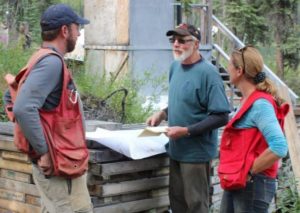
Exploration is now underway a yet a third AurMac target, Aurex Hill.  Aurex Hill is approximately 1 km east of the Powerline deposit and includes a large (roughly 10 km2) area containing a coincident gold and arsenic-in-soils geochemical anomaly.
Overall, the AurMac Project is situated between existing mines – Victoria Gold’s Eagle gold mine and Alexco Resource’s 300 million ounce Bellekeno silver mine. Infrastructure includes road, power, communications and an airport.
The Hyland Gold Project hosts an Indicated Mineral Resource of 8.6 million tonnes grading 0.85 g/t gold equivalent (AuEq), for 236,000 AuEq ounces with an Inferred Mineral Resource of 10.8 million tonnes grading 0.83 g/t AuEq, for 288,000 AuEq ounces at a 0.3 g/t AuEq cut-off. This resource is located in what is known as the Main Zone, is open in all directions and at depth, and has the potential to host a multi-million ounce deposit.
The Hyland Gold Project is interpreted as sediment-hosted, structurally controlled, Carlin-style gold mineralization. The Hyland Gold project consists of the Main Zone, Camp Zone, Cuz Zone, and Montrose Ridge Zone that extends over 11 km. Column leach tests average oxide gold recoveries are 86%. There is existing infrastructure, including roads and camps.
At the close of a recent $4.74 million private placement financing, the major shareholders will be Alexco Resource Corp. (9.3%), Victoria Gold Corp. (7.9%), Sprott (3%) and Osisko Gold Royalties (4.9%). Banyan Gold is well funded with over $6 million in its treasury, sufficient for its planned 10,000 metres of drilling, metallurgical studies, a Lidar survey, geophysics, soil sampling, community relations and baseline environmental studies. Banyan’s team consists of an experienced group of explorers with a track record of success.
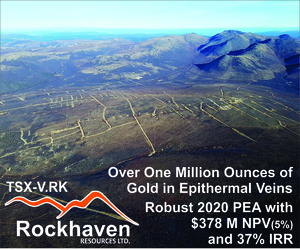 Rockhaven Resources Ltd. [RK-TSXV] has started the 2020 diamond drill program at its 100%-owned, road-accessible Klaza property, located in the Dawson Range gold belt of southern Yukon 50 km west of Carmacks. The exploration program is being funded by a $5.2 million private placement financing.
Rockhaven Resources Ltd. [RK-TSXV] has started the 2020 diamond drill program at its 100%-owned, road-accessible Klaza property, located in the Dawson Range gold belt of southern Yukon 50 km west of Carmacks. The exploration program is being funded by a $5.2 million private placement financing.
The program includes a minimum of 6,000 metres of diamond drilling designed to evaluate high-priority targets that lie outside of the Klaza deposit itself, which includes Indicated Resources of 4.5 Mt containing 686,000 oz gold and 14,071,000 oz silver at grades of 4.8 g/t gold and 98 g/t silver, and Inferred Resources of 5.7 Mt containing 507,000 oz gold and 13,901,000 oz silver at grades of 2.8 g/t gold and 76 g/t silver.
An updated Preliminary Economic Assessment of the Klaza deposit, announced in July 2020, returned a post-tax NPV5% of $378-million and an IRR of 37% based on a gold price of US$1,450/oz and a silver price of US$17.
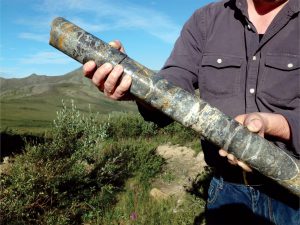 The company will be advancing the Klaza Project toward Prefeasibility and will also expand camp infrastructure as well as drill pad and access construction in anticipation of a 25,000-metre drill program scheduled for 2021.
The company will be advancing the Klaza Project toward Prefeasibility and will also expand camp infrastructure as well as drill pad and access construction in anticipation of a 25,000-metre drill program scheduled for 2021.
“Rockhaven plans to build on the robust economics of the recent PEA by testing high-priority targets elsewhere on our camp-scale Klaza property,” stated Matt Turner, CEO. “We feel it is prudent to test these targets now as promising discoveries can be fast tracked to expand inferred mineral resources before Rockhaven transitions into detailed Prefeasibility-level work next year.”
Diamond drilling will evaluate a number of targets including the Rusk target (10 drill holes) located 3 km south of the Klaza deposit, the Victoria target 1.5 km east of the Klaza deposit, and the Pearl Zone located 500 metres north pf the Klaza Zone.
Other drill holes are designed to expand resource down-dip from then Klaza deposit where previous holes intersected high-grade gold and silver values. At least one even-deeper hole is planned to test four subzones to demonstrate potential for high-grade resource expansion further to depth.
